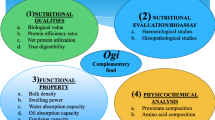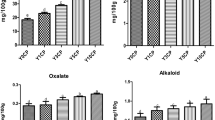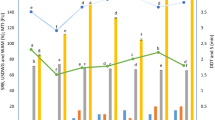Abstract
The promotion and enrichment of underutilized cereal based foods with legumes and oilseeds are receiving considerable attention in order to reduce the menace of protein and micronutrients malnutrition. This research therefore investigated the quality of flour produced from fonio (Digitaria iburua) and pigeon pea (Cajanus cajan) blend. Fonio and pigeon pea flour blends (100:0, 95:5, 90:10, 85:15 and 80:20 of fonio to pigeon pea) were analyzed for proximate, vitamin, mineral elements and amino acids. The flour blend with highest level of fiber, protein, ash and some essential amino acids (80:20 fonio to pigeon pea) and 100% fonio were developed into breakfast food and sensory attributes such as colour, taste, flavour and overall acceptability were evaluated. The results obtained were moisture (6.74–7.78%), protein (12.19–24.85%), fat (0.98–1.25%), crude fibre (1.03–1.20%), ash (0.58–1.03%), carbohydrates (63.69–77.77%) and energy (363.09–371.53 kcal/100 g). Eighteen amino acids comprising essential and non essential amino acids were identified in the flour samples. The essential amino acids were phenylalanine, histidine, isoleucine, leucine, lysine, methionine, threonine, tryptophan and valine. Vitamins identified in the samples were A, B1, B2, B5, B6, B9, C, D, E and K. Significant amount of mineral elements were also recorded. The result of this study revealed that substitution of fonio grain with pigeon pea increased the protein, ash, some amino acids and vitamins of the flour blends. Sensory evaluation of all the attributes of the breakfast food ranked above like-moderately on the 9-point hedonic scale. The flour mixes can be used in the production of breakfast food.
Similar content being viewed by others
References
Abdul SD, Jideani AIO (2019) Fonio (Digitaria spp.) breeding. In: Al-Khayri J, Jain S, Johnson D (eds) Advances in plant breeding strategies: cereals. Springer, Cham
Abioye VF, Babarinde GO (2009) Potentials of fonio for production of breakfast meal. J Ultra Sci Phys Sci 21:233–238
Adekunle AJ, Abiodun AV (2018) Proximate Composition, physical and sensory quality of acha-moringa seed flour blends biscuits. AFSJ 5(2):1–7
Adeoti OA, Elutilo OO, Babalola JO, Jimoh KO, Azeez LA, Rafiu KA (2013) Proximate, mineral, amino acid and fatty acid compositions of maize tuwo-cirina forda flour blends. Greener J Biol Sci 3:165–171
Adolphus K, Lawton CL, Dye L (2013) The effects of breakfast on behavior and academic performance in children and adolescents. Front Hum Neurosci 7:425
Akinwande BA, Babarinde GO, Ajeigbe OP (2014) Production and evaluation of ready to-eat breakfast cereals from blends of whole maize and African yam bean (Sphenostylis stenocarpa). Elixir Food Sci 72:25625–25628
Akubor PI (2017) Effect of processing methods on the chemical composition and functional properties of pigeon pea seed. AJAAR 2(2):1–8. https://doi.org/10.9734/AJAAR/2017/35640
Al-Fartusie FS, Mohssan SJ (2017) Essential trace elements and their vital roles in human body. Indian J Adv Chem Sci 5(3):127–136
Annongu AA, Edoh JH, Kayode RMO, Gawati AO, Aremu JO, Bello-Bukoye ZO, Yusuff AT, Eifediyi EK (2019) Phytochemicals and nutrients constituents of varieties of hungry rice and their significance in nutrition. IJRP 41(1):1–10
AOAC (2005) Official method of analysis, 15th edn. Association of Official Analytical Chemists, Washington, DC
Awolu OO, Omoba OS, Olawoye OA, Dairo M (2017) Optimization of production and quality evaluation of maize-based snack supplemented with soybean and tigernut (Cyperus esculenta) flour. Food Sci Nutr 5:3–13. https://doi.org/10.1002/fsn3.359
Ayo JA, Ayo VA, Nkama I, Adewori R (2007) Physicochemical, in vitro digestibility and organoleptic evaluation of fonio wheat biscuit supplemented with soybean flour. Niger Food J 25(1):77–89
Ciulu M, Solinas S, Floris I, Panzanelli A, Pilo MI, Piu PC, Spano N, Sanna G (2011) RP-HPLC determination of insoluble and soluble vitamins in honey. Talanta 83:924–929. https://doi.org/10.1016/j.talanta.2010.10.059
Coda R, Di Cagno MO, Edema MO, Nionelli L, Gobbeti M (2010) Exploitation of acha (Digitaria exilis) and Iburu (Digitaria iburua) flours: chemical characterization and their use for sourdough fermentation. Food Microbiol 27:1043–1050
Egbebi AO, Muhammad AA (2016) Assesment of physicochemical and phytochemical properties of white fonio (Digitaria exilis) flour. Int J Biol Pharm Sci 2(1):17–27
El-Tabey S, Ahmed M (1992) Hard-to-cook phenomenon in legumes. Food Rev Int 8:191–221. https://doi.org/10.1080/87559129209540938
FAO/WHO (1998) Carbohydrates in human nutrition: report of a Joint FAO/WHO Expert Consultation, 14–18 April 1997, Rome. FAO Food and Nutrition Paper No. 66. Rome
Fliedel G, Ouattara M, Grabulos J, Dramé D, Cruz J (2004) Effect du blanchiment mécanique sur la qualité technologique, culinaire et nutritionnelle du fonio, cereal d’Afrique de l’Ouest. In: Brouwer Inge D, Traoré Alfred S, Trèche S (eds) Voies alimentaires d’amélioration des situations nutritionnelles en Afrique de l’Ouest: Le role des technologues alimentaires et des nutritionnistes: actes du 2e Atelier international, Ouagadougou, 23–28 Nov 2003. Presses universitaires de Ouagadougou, Burkina Faso, Ouagadougou, pp 599–614
Institute of Medicine (US) Standing Committee on the Scientific Evaluation of Dietary Reference Intakes (1998). Dietary reference intakes for thiamin, riboflavin, niacin, vitamin B6, folate, vitamin B12, pantothenic acid, biotin, and choline. National Academics Press (US), Washington (DC)
Jideani IA (2012) Digitaria exilis (acha/fonio), D. ibura (iburu/fonio) and Eluesine coracana (tamba/finger millet)—non conventional cereal grains with potentials. Sci Res Essays 7:3834–3843. https://doi.org/10.5897/SRE12.416
Kwon-Ndung EH, Ochigbo AA (2001) Acha (fonio) genetic diversity, distribution and conservation in Nigeria. In: Kwon-Ndung Emmanuel H (ed) Genetics and food security in Nigeria. GSN Publication, Nigeria, pp 18–20
Lebiedzinska A, Marszall ML, Kuta J, Szefer P (2007) RP-HPLC method with colometric electrochemical and ultra violet detection for the quantification of vitamin B and animal plant foods. J Chromatogr 1173:71–80. https://doi.org/10.1016/j.chroma.2007.09.072
Moore S, Stein WH (1963) Chromatographic amino acids determination by the use of automatic recording equipment. Methods Enzymol 6:819–831
Ogunbusola EM (2017) Nutritional and antinutritional composition of calabash and bottle gourd seed flours (var Lagenaria siceraria). J Culinary Sci Technol. https://doi.org/10.1080/15428052.2017.1390518
Okoye JI, Ojimelukwe PC, Ukom AN (2016) Amino acid composition and protein quality of wheat flour biscuits fortified with soybean and bambara groundnut flours. GJESR Res Pap 3(4):8–19
Omoba OS, Awolu OO, Olagunju AI, Akomolafe AO (2013) Optimization of plantain brewer’s spent grain biscuit using responses surface methodology. J Sci Res Rep 2:665–681. https://doi.org/10.9734/JSRR/2013/4944
Onimawo IA, Asugo S (2008) Effects of germination on the nutrient content and functional properties of pigeon pea flour. J Food Sci Technol 41:170–174
Onweluzo JC, Nwabugwu CC (2009) Fermentation of millet (Pennisetum americanum) and pigeon pea (Cajanus cajan) seeds for flour production: effects on composition and selected functional properties. Pak J Nutr 8:737–744
Oshodi AA, Olaofe O, Hall GM (1993) Amino acid, fatty acid and mineral composition of pigeon pea (Cajanus cajan). Int J Food Sci Nutr 43:187–191. https://doi.org/10.3109/09637489309027541
Quanhong L, Tianze C, Caitongyi P (2003) Study on the action of pigeon pea protein. J Chin Inst Food Sci Technol 1:7–11
Raji AO, Nassam HO, Aruna TE, Raji MO, Sani M (2017) Effect of cooking time on the physical and thermal properties of acha seeds. IJFS 6:178–191
Raji AO, Nassam HO, Abolaji G, Ayorinde JO, Raji MO (2018) Nutritional properties of fonio starch-defatted moringa seed flour blends prepared at different ratios. Croat J Food Sci Technol 10(2):145–156
Richardson DP (1997) The addition of nutrients to foods. Proc Nutr Soc 56:807–825
Vasal SK (2004) The role of high lysine cereals in animal and human nutrition in Asia. In: He C (ed) Protein sources for the animal feed industry. FAO, Rome, pp 167–183
Victor JT, James DB (1991) Proximate chemical composition of fonio grains. J Food Sci Agric 56:561–563. https://doi.org/10.1002/jsfa.2740560415
Zuraini A, Somchit MN, Solihah MH, Goh YM, Arifah AK, Zakaria MS, Somchit N, Rajion MA, Zakaria ZA, MatJais AM (2006) Fatty acid and amino acid compositions of three local Malaysian Channa fish spp. Food Chem 97:674–678. https://doi.org/10.1016/j.foodchem.2005.04.031
Acknowledgements
This work was supported by the Federal Government of Nigeria under the scheme of Tertiary Educational Trust Fund (TETFund) Institution-based Research Grant, Ladoke Akintola University of Technology, Ogbomoso, Nigeria (LAUTECH2017).
Author information
Authors and Affiliations
Corresponding author
Additional information
Publisher's Note
Springer Nature remains neutral with regard to jurisdictional claims in published maps and institutional affiliations.
Rights and permissions
About this article
Cite this article
Babarinde, G.O., Adeyanju, J.A., Ogunleye, K.Y. et al. Nutritional composition of gluten-free flour from blend of fonio (Digitaria iburua) and pigeon pea (Cajanus cajan) and its suitability for breakfast food. J Food Sci Technol 57, 3611–3620 (2020). https://doi.org/10.1007/s13197-020-04393-7
Revised:
Accepted:
Published:
Issue Date:
DOI: https://doi.org/10.1007/s13197-020-04393-7




